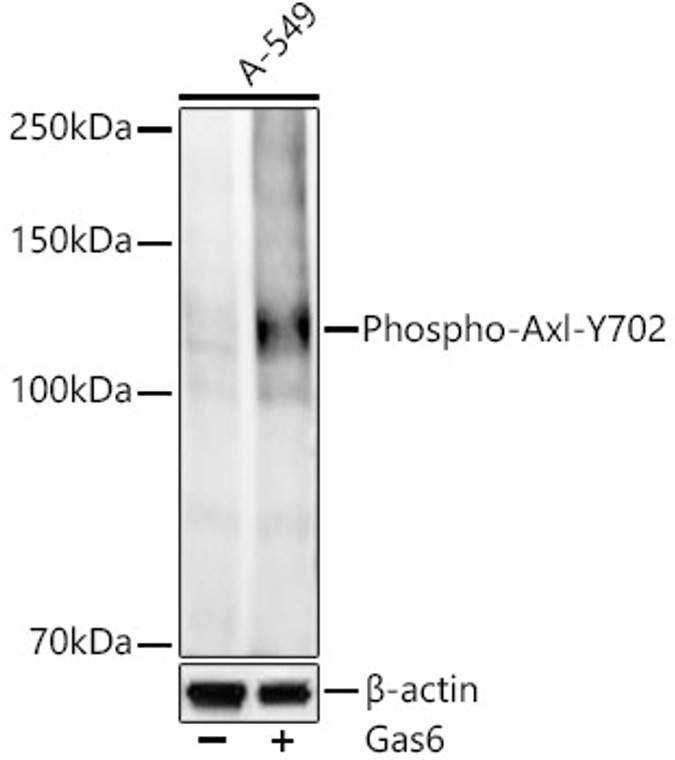| Host: |
Rabbit |
| Applications: |
WB |
| Reactivity: |
Human |
| Note: |
STRICTLY FOR FURTHER SCIENTIFIC RESEARCH USE ONLY (RUO). MUST NOT TO BE USED IN DIAGNOSTIC OR THERAPEUTIC APPLICATIONS. |
| Short Description: |
Rabbit monoclonal antibody anti-Phospho-Tyrosine-Protein Kinase Receptor Ufo-Y702 is suitable for use in Western Blot research applications. |
| Clonality: |
Monoclonal |
| Clone ID: |
S5882RM |
| Conjugation: |
Unconjugated |
| Isotype: |
IgG |
| Formulation: |
PBS with 0.05% Proclin300, 0.05% BSA, 50% Glycerol, pH7.3. |
| Purification: |
Affinity purification |
| Dilution Range: |
WB 1:500-1:1000 |
| Storage Instruction: |
Store at-20°C for up to 1 year from the date of receipt, and avoid repeat freeze-thaw cycles. |
| Gene Symbol: |
AXL |
| Gene ID: |
558 |
| Uniprot ID: |
UFO_HUMAN |
| Immunogen: |
A synthetic phosphorylated peptide around Y702 of human Axl (NP_068713.2). |
| Tissue Specificity | Highly expressed in metastatic colon tumors. Expressed in primary colon tumors. Weakly expressed in normal colon tissue. |
| Post Translational Modifications | Monoubiquitinated upon GAS6-binding. A very small proportion of the receptor could be subjected to polyubiquitination in a very transient fashion. Phosphorylated at tyrosine residues by autocatalysis, which activates kinase activity. |
| Function | Receptor tyrosine kinase that transduces signals from the extracellular matrix into the cytoplasm by binding growth factor GAS6 and which is thus regulating many physiological processes including cell survival, cell proliferation, migration and differentiation. Ligand binding at the cell surface induces dimerization and autophosphorylation of AXL. Following activation by ligand, AXL binds and induces tyrosine phosphorylation of PI3-kinase subunits PIK3R1, PIK3R2 and PIK3R3.but also GRB2, PLCG1, LCK and PTPN11. Other downstream substrate candidates for AXL are CBL, NCK2, SOCS1 and TNS2. Recruitment of GRB2 and phosphatidylinositol 3 kinase regulatory subunits by AXL leads to the downstream activation of the AKT kinase. GAS6/AXL signaling plays a role in various processes such as endothelial cell survival during acidification by preventing apoptosis, optimal cytokine signaling during human natural killer cell development, hepatic regeneration, gonadotropin-releasing hormone neuron survival and migration, platelet activation, or regulation of thrombotic responses. Also plays an important role in inhibition of Toll-like receptors (TLRs)-mediated innate immune response. (Microbial infection) Acts as a receptor for lassa virus and lymphocytic choriomeningitis virus, possibly through GAS6 binding to phosphatidyl-serine at the surface of virion envelope. (Microbial infection) Acts as a receptor for Ebolavirus, possibly through GAS6 binding to phosphatidyl-serine at the surface of virion envelope. (Microbial infection) Promotes Zika virus entry in glial cells, Sertoli cells and astrocytes. Additionally, Zika virus potentiates AXL kinase activity to antagonize type I interferon signaling and thereby promotes infection. Interferon signaling inhibition occurs via an SOCS1-dependent mechanism. |
| Protein Name | Tyrosine-Protein Kinase Receptor UfoAxl Oncogene |
| Database Links | Reactome: R-HSA-4420097 |
| Cellular Localisation | Cell MembraneSingle-Pass Type I Membrane Protein |
| Alternative Antibody Names | Anti-Tyrosine-Protein Kinase Receptor Ufo antibodyAnti-Axl Oncogene antibodyAnti-AXL antibodyAnti-UFO antibody |
Information sourced from Uniprot.org
12 months for antibodies. 6 months for ELISA Kits. Please see website T&Cs for further guidance






